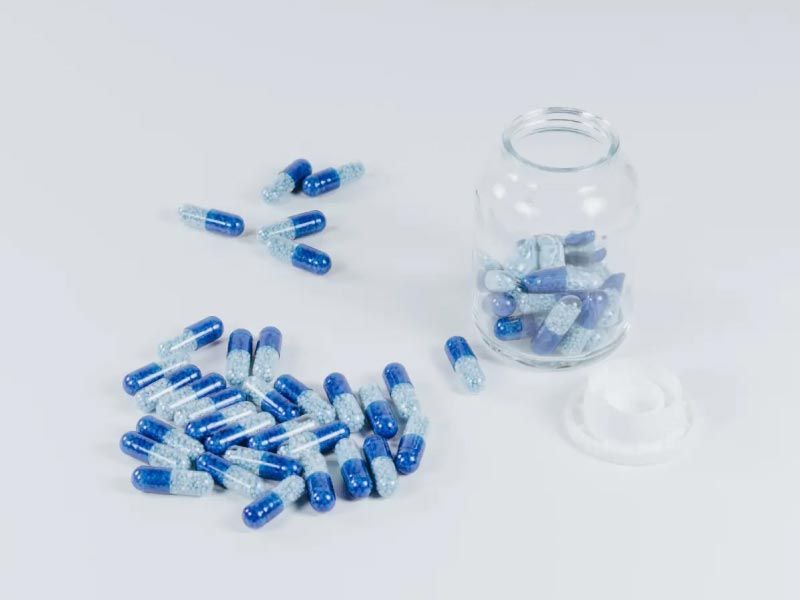
Vaginitis vs. Yeast Infection
Published on June 30, 2025
Written by Kathleen Morrison
Medically Reviewed by Andrea Sleeth WHNP-BC, MSCP
Let’s clear up a common mix-up: vaginitis and yeast infections are not the same thing. Vaginitis is the umbrella term for irritation or inflammation in your vagina, and a yeast infection is just one possible cause.
Vaginitis can show up thanks to bacteria, yeast, or even your body reacting to things like scented products. Itching, burning, and weird discharge are all signs that something’s off. A yeast infection, specifically, happens when there’s an overgrowth of a natural fungus called Candida.
They might feel similar, but they need different treatments—so grabbing whatever’s on the drugstore shelf might not cut it. Knowing the difference helps you know when you're at increased risk and allows you to take the right steps when something uncomfortable pops up.
Vaginitis
Vaginitis is the umbrella term for when your vagina’s balance is thrown off and inflammation steps in. It’s super common and treatable.
There are a few main types:
- Bacterial vaginosis (BV): Happens when the good bacteria (Lactobacillus bacteria) in your vagina get outnumbered by the not-so-good kind.
- Yeast infections: Caused by an overgrowth of Candida, a natural fungus that you have growing anyway, but sometimes gets too comfortable.
- Trichomoniasis: A common STI caused by a tiny parasite.
- Irritant vaginitis: Triggered by things like scented products, soaps, or tight clothes that don’t agree with your body.
All of these can cause similar symptoms, which is why getting a proper diagnosis matters. But not all vaginitis is caused by germs. Some types happen when hormones shift or your body reacts to outside irritants.
- Atrophic vaginitis: Caused by low estrogen, common during or after menopause. Can lead to dryness, discomfort, or painful sex.
- Allergic or irritant vaginitis: Triggered by things like latex, spermicide, or harsh soaps.
- Inflammatory vaginitis: Less common, and usually needs a provider’s help to diagnose and treat.
Vaginitis symptoms
Your vagina will usually let you know when something’s off. Common signs include:
- A change in vaginal discharge (color, smell, or texture)
- Itching or burning
- Discomfort during vaginal sex or when peeing
- A fishy or sour odor (especially with BV)
- Soreness or swelling
Basically—if it feels different, it probably is.
Causes and risk factors
Your vaginal ecosystem is pretty amazing, but it can be thrown off by:
- Intercourse (especially with new people or if you have multiple sexual partners)
- Douching or using scented products
- Antibiotics
- Hormonal shifts (like pregnancy, menopause, or starting birth control)
- Stress, tight clothing, or staying in wet clothes for too long
Your good bacteria (hi, lactobacillus!) are key to keeping things balanced. When they’re disrupted, infections are more likely to show up.
Vaginal Yeast Infections
Yeast infections are super common—around 3 in 4 women will deal with one at some point. They’re caused by Candida fungus, a type of fungus that normally hangs out in your vagina without causing trouble. But when things get a little off-balance, Candida can multiply and make itself very known.
This isn’t usually something you “catch” from a partner—it’s more of an internal shift. Candida loves warm, damp environments and feeds on sugar, so anything that fuels that (think: tight clothes, high blood sugar, antibiotics) can give it the green light.
Yeast Infection symptoms
Yeast infections are pretty recognizable once you’ve had one (and memorable if it’s your first). Look out for:
- Intense vaginal itching (we’re talking can’t-sleep level discomfort)
- Thick, white discharge that’s clumpy—like cottage cheese
- A burning sensation when you pee or during sex
- Redness, swelling, or tiny cracks around your vulva
They usually don’t come with a strong odor (that’s more BV’s thing), which helps clue you in. Prescription antifungals like fluconazole are the best yeast infection treatment, and way easier to grab than guessing at the drug-store shelf.
Wisp treatment options are available only after consultation with a licensed medical professional. You should consult with your healthcare provider before starting a new supplement or treatment regimen. Individual results may vary.
Causes and risk factors
Candida is part of your body's normal flora—it’s just that sometimes it overstays its welcome. Here's what can cause it to go rogue:
- Antibiotics (they wipe out the good bacteria that keep yeast in check)
- Pregnancy or hormonal shifts (yeast loves estrogen)
- High blood sugar (hello, sweet tooth)
- Weakened immune system (from stress, illness, or lack of sleep)
- Tight, synthetic clothing (aka yeast’s dream habitat)
When Candida overgrows, it sticks to vaginal cells, forms a protective film, and releases stuff that triggers irritation. That's when symptoms kick in—and why it can be hard to shake without the right treatment.
Yeast Infections that keep coming back
If you’re getting yeast infections repeatedly—like four or more a year—you’re not alone. We know it sucks.
Recurrent vaginitis affects up to 8% of women and can feel so frustrating. Sometimes it’s genetic, sometimes it’s due to an underlying condition like diabetes, and sometimes the infection just wasn’t fully cleared the first time.
Your partner can occasionally carry yeast, too, which makes reinfection possible (though less common than most people think).
When it keeps coming back, a longer treatment plan, probiotics, or lifestyle changes might be needed to help keep your vagina happy. That could mean cutting back on sugar, swapping to cotton underwear, or finding better ways to manage stress.
Diagnosis for Vaginitis vs. Yeast Infections
You know your body best, but when something feels off, figuring out exactly what’s going on is the first step toward feeling better. Discharge, itching, irritation... they can all point to different things, and sometimes those things look super similar on the surface. That’s why a quick chat (and maybe a test or two) with a provider can make all the difference.
They’ll usually start with a few questions: What have you noticed? Has it happened before? When did it start? What makes it better or worse? It’s all about getting a full picture—not judgment, just helpful info.
Tests that can tell you something
To get a clear picture, your provider might use:
- A quick pH test: Yeast infections usually stick to a normal vaginal pH, but BV doesn’t.
- A swab under the microscope: This can show yeast cells, clue cells (signs that point to BV), or other things like parasites.
- A DNA-based test: Super accurate and helpful when symptoms don’t tell the whole story.
These tools help make sure you’re getting exactly the care you need, right from the start—no guessing games, no trial-and-error treatments.
Pelvic exams
No one loves a pelvic exam—but it’s often the fastest way to get real answers. During the exam, your provider takes a look at your vulva, vagina, and cervix to spot any redness, swelling, discharge, or anything else that stands out.
If needed, they’ll collect a sample for testing. Sometimes they’ll do a “whiff test” (yes, that’s exactly what it sounds like) to look for a fishy odor to help rule in or out BV. They may also check for tenderness that points to something deeper, like pelvic inflammatory disease.
Could it be an STI?
Sometimes symptoms that seem like an infection are actually not an infection at all, and not every infection is sexually transmitted. But when sexually transmitted infections are the cause, it's important to know so you can treat it right and keep partners in the loop.
Here’s a quick vibe check:
- Trichomoniasis is an STI that can totally mimic vaginitis. Unlike yeast or BV, it usually means your partner should get treated too.
- Chlamydia and gonorrhea can cause weird vaginal discharge or irritation, but they often affect the cervix more than the vagina.
- Irritant vaginitis comes from soaps, detergents, or even new fabrics, not infections at all.
- And some conditions, like lichen sclerosus or vulvodynia, cause itching and pain without any infection behind them.
Bottom line: Vaginal symptoms don’t always have one cause. Getting checked means you can skip the guesswork and finally feel better, for real.
Treating Vaginitis vs. Yeast Infections
When something feels off down there, getting the right treatment is key—and that means matching your symptoms with the right meds. The good news? Once you know what you're dealing with, most vaginal infections are easily treatable.
Treating Yeast Infections
If you’re dealing with a yeast infection, prescription antifungal medications are your go-to. You’ve got a few ways to tackle it—oral pills, vaginal creams, or suppositories—so you can pick what feels best for you.
- Oral fluconazole is a popular single-dose pill that’s easy and convenient for most uncomplicated yeast infections.
- Vaginal creams and suppositories—like miconazole, clotrimazole, or tioconazole—work quickly and come in one-, three-, or seven-day treatments. Some also include external creams to soothe itching and irritation.
- For mild infections, over-the-counter options often do the trick. But if you’ve had multiple infections or symptoms are severe, prescription-strength treatments or longer courses might be needed.
- In stubborn or recurring cases, some providers suggest weekly fluconazole for a few months as a maintenance plan.
There’s also boric acid suppositories—additional help which some women find helpful for yeast infections that don’t respond as well to usual treatments. These create a vaginal environment less friendly to yeast and harmful bacteria. They’re usually used nightly for one to two weeks but should never be taken by mouth and aren’t recommended during pregnancy.
Treating Bacterial Vaginosis and other common vaginal infections
Bacterial vaginosis and other types of vaginitis call for different treatments because the causes vary.
- To treat BV, you'll need prescription antibiotics like metronidazole or clindamycin, which you can take orally or apply vaginally. Metronidazole by mouth works well but might cause nausea or a metallic taste. Vaginal gels or creams minimize these side effects but require nightly use.
- For trichomoniasis—a common STI causing vaginitis symptoms—higher doses of metronidazole or tinidazole are used, and your partner will need treatment too.
- Irritant vaginitis (caused by reactions to soaps, products, or allergens) isn’t about infection but inflammation, so treatment focuses on removing triggers and using soothing moisturizers.
- Hormonal changes causing vaginal dryness or inflammation might call for estrogen therapy or vaginal moisturizers.
Some women look into vaginal sprays or probiotic products to help with their vaginal health, but the vagina usually does just fine on its own. If you try sprays, choose unscented, pH-balanced options that won't mess with your vaginal flora and stop use if irritation pops up.
When to get professional help
Knowing when to see a provider can make all the difference.
- First-time symptoms or unusual changes deserve a proper check.
- If symptoms return shortly after your vaginitis treatment, you might need a different approach.
- Severe pain, fever, heavy or unusual discharge, or pelvic discomfort calls for prompt care.
- Pregnant folks should always consult before starting any over-the-counter treatments.
No need to guess—talking to a healthcare pro means getting the right answers and feeling confident about your health.
How your health and lifestyle shape vaginal wellness
Taking care of your vaginal health isn’t just about treatments—it’s also about how your overall health and daily habits play into the picture. Understanding these connections gives you more power to keep things feeling comfortable down there.
Hormones and birth control
Birth control pills and hormones can shift the natural ecosystem of your vagina. Some types raise estrogen levels, which boosts vaginal glycogen—a kind of sugar yeast loves to snack on. This can make yeast infections more likely.
So if you notice a pattern when starting or switching contraception, it’s completely normal. Lower-dose or progestin-only options often have less impact if you’re sensitive.
Your immune system
Your immune system is your best defender against pesky infections. When stress piles up, sleep is short, or illnesses and certain medications weigh you down, your defenses dip—and that’s when infections might sneak in more easily.
Supporting your immune health with good sleep, balanced nutrition, and stress relief isn’t just great for you overall—it helps keep your vaginal ecosystem happy, too.
Everyday habits for a happy vagina
Simple daily moves go a long way in keeping your vagina happy and healthy. Here are some easy habits to adopt:
- Always wipe from front to back to avoid introducing unwanted bacteria.
- Skip douching—your vagina is self-cleaning, and douching can mess with its natural balance.
- Change tampons and pads regularly during your period to avoid creating a breeding ground for bacteria.
- Try to pee after sex (ASAP!) to help flush out any bacteria that might have entered your urethra.
- Pay attention to how your body reacts to different lubricants or condoms—switch them up if you notice irritation or infections.
- Using barrier methods during oral sex can also support vaginal health.
Choosing the right care for your vaginal health
Understanding the whole vaginitis vs. yeast infection deal is what'll help you make quicker decisions when you're feeling uncomfy.
The real secret? Getting the right diagnosis. Pay attention to your body—what your discharge looks like, if there’s any smell, and how your skin feels. If you’re unsure, don’t guess. Seeing a healthcare pro helps you get the right care faster and keeps things from getting worse with the wrong treatment.
Taking care of your vaginal health is an ongoing thing. Supporting good bacteria with probiotics, practicing gentle hygiene (without going overboard), and making thoughtful lifestyle choices all help keep your vagina happy. And with trusted treatment options now easily accessible online, it’s never been simpler to manage these common issues on your own terms.
Ready to take control? Wisp makes it easy to get expert-backed prescription treatment for vaginitis and yeast infections delivered discreetly to your door. No awkward doctor visits, just straightforward care when you need it most.
Frequently Asked Questions (FAQ):
How do I know if I have BV or yeast infection?
BV usually brings on a thin, gray discharge with a fishy smell, while yeast infections tend to come with thick, white, cottage cheese-like discharge. The best way to know for sure? Get checked by a healthcare pro.
What does vaginitis look like?
Symptoms vary but often include redness, swelling, irritation, and unusual discharge. What you see depends on what’s causing it—yeast, BV, or something else.
What do BV and a yeast infection look like together?
You might notice a combo of symptoms—thick white discharge from the yeast and thin gray discharge with an odor from BV, plus itching and discomfort. Getting the right diagnosis makes all the difference.
Will vaginitis go away on its own?
Some mild cases of vaginitis, especially those caused by irritants or hormonal changes, may resolve on their own once the trigger is removed. However, infections like yeast or bacterial vaginosis typically require prescription treatment to clear up symptoms.
This blog post is for informational and educational purposes only and should not be taken as professional advice. Always consult with a qualified professional before making any decisions based on the information provided here.

Bacterial Vaginosis & Yeast Swab Test Kit by Wisp
$159.00
At-home test for Bacterial Vaginosis and Yeast Infections.



